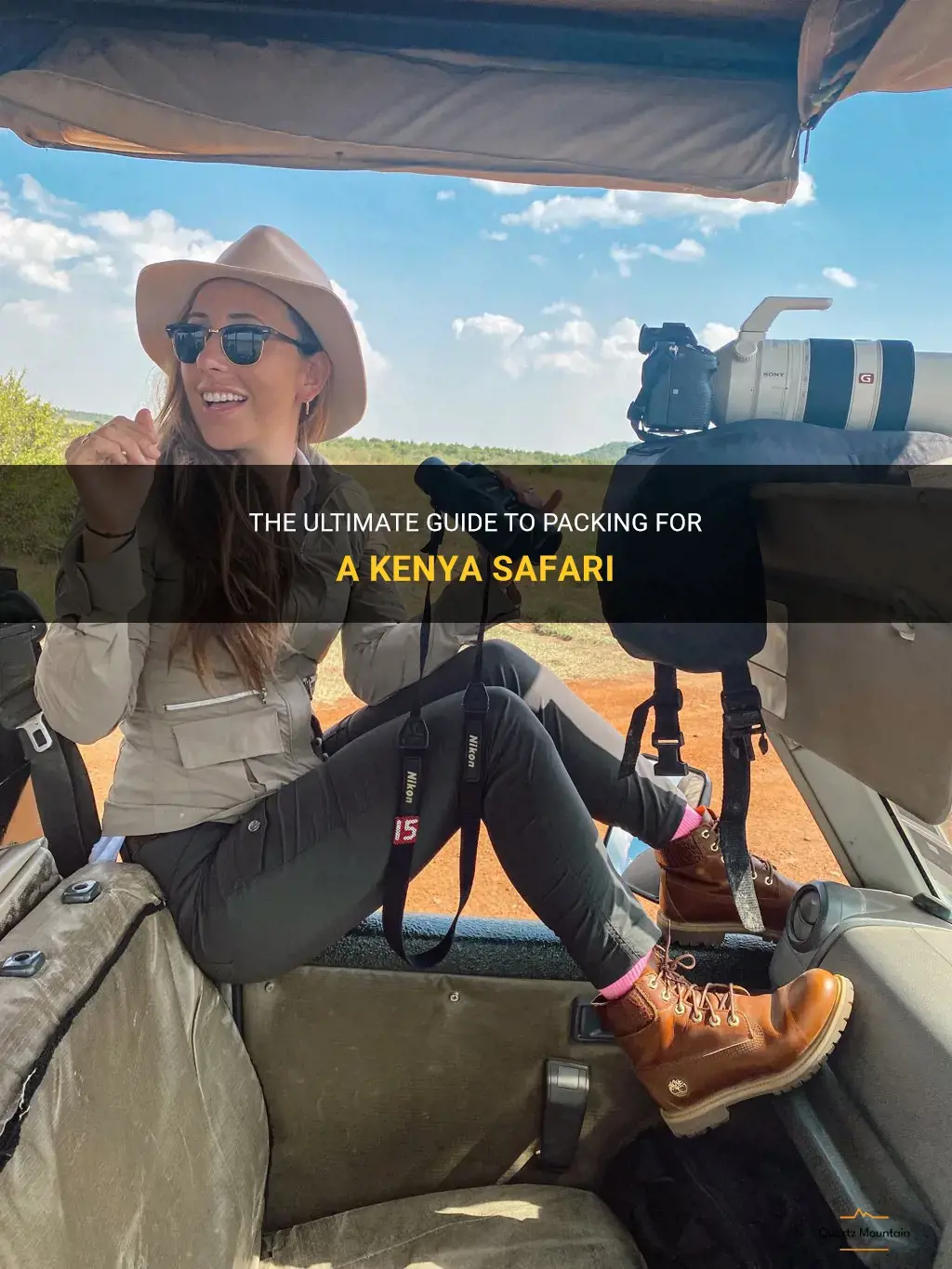
Are you planning a once-in-a-lifetime Kenya safari adventure? Whether you’re exploring the vast savannahs of the Maasai Mara or tracking elusive rhinos in Amboseli National Park, packing the right gear is essential for a successful and comfortable trip. In this ultimate guide, we will dive into everything you need to know about packing for a Kenya safari, from clothing and footwear to essential items and helpful tips. So grab your duffel bag and get ready to embark on the safari of your dreams!
| Characteristics | Values |
|---|---|
| Clothing | Light and breathable |
| Neutral colors | |
| Long-sleeved shirts | |
| Loose-fitting pants | |
| Hat and sunglasses | |
| Comfortable walking shoes | |
| Swimwear | |
| Scarf or shawl for evenings | |
| Weather | Hot and dry |
| Cool evenings | |
| Chance of rain | |
| Average temperatures: 20-30°C | |
| Health | Malaria risk |
| Vaccinations | |
| First aid kit | |
| Sunscreen and insect repellent | |
| Equipment | Binoculars |
| Camera with zoom lens | |
| Extra batteries | |
| Universal adapter | |
| Torch or headlamp | |
| Water bottle | |
| Backpack or daypack | |
| Money and travel documents | |
| Portable charger | |
| Travel insurance | |
| Wildlife | Lions |
| Elephants | |
| Rhinos | |
| Giraffes | |
| Zebras | |
| Hippos | |
| Wildebeests | |
| Cheetahs | |
| Leopards |
What You'll Learn
- What essential clothing items should I pack for a Kenya safari?
- What type of footwear is recommended for a safari in Kenya?
- Are there any specific items I should bring to protect against insects or mosquitoes during a safari in Kenya?
- Is there any specialized equipment or gear that is recommended for a Kenya safari?
- Are there any cultural considerations to keep in mind when packing for a safari in Kenya?

What essential clothing items should I pack for a Kenya safari?
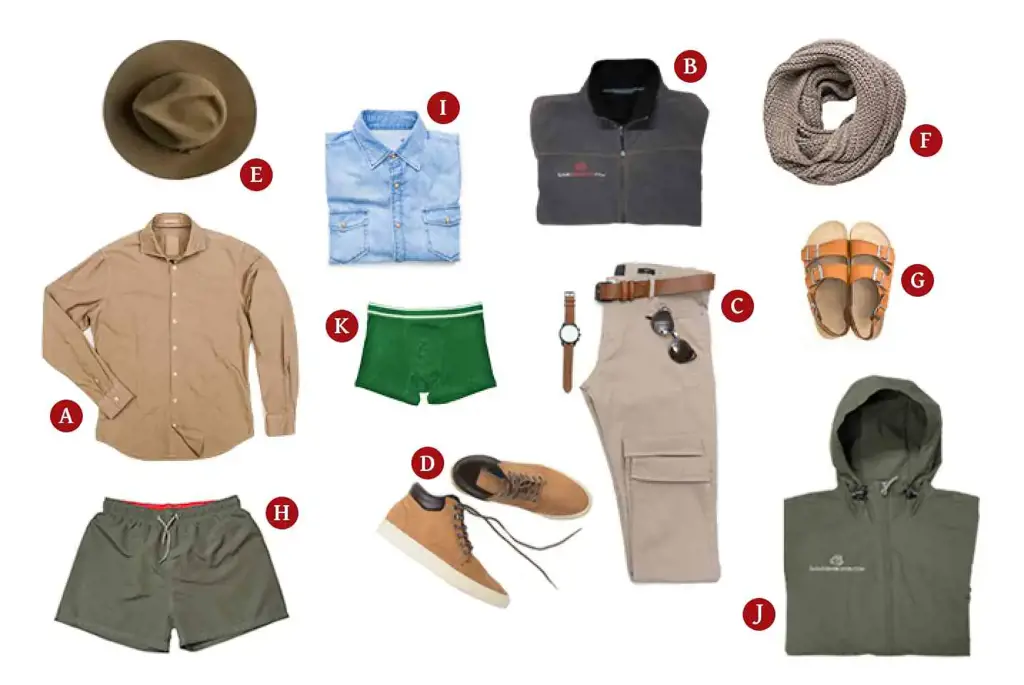
When packing for a Kenya safari, it is essential to bring the right clothing items to ensure both comfort and protection in the wild. The right clothing will shield you from the elements and minimize your risk of insect bites and sunburn. Here are some essential clothing items you should pack for a Kenya safari:
- Lightweight and breathable clothing: Opt for lightweight and breathable fabrics such as cotton or linen to keep you cool in the hot and humid climate. Loose-fitting clothes will also help you stay comfortable during long game drives and bush walks.
- Long-sleeved shirts and pants: To protect yourself from the sun and prevent insect bites, pack long-sleeved shirts and pants. These will shield your skin from harmful UV rays and minimize your exposure to mosquitoes and other insects.
- Neutral-colored clothing: Neutral-colored clothing, such as khaki or green, will help you blend in with the natural surroundings and make it easier to spot wildlife. Avoid bright or colorful patterns that may scare off animals or attract unwanted attention.
- Hat with a wide brim: A wide-brimmed hat will provide shade for your face, neck, and ears, reducing your risk of sunburn. Look for a hat with UPF (ultraviolet protection factor) to provide additional sun protection.
- Sturdy walking shoes: Choose comfortable and supportive walking shoes that are suitable for both on and off-road excursions. Opt for closed-toe shoes to protect your feet from sharp objects and insects.
- Swimsuit: Some lodges and camps have swimming pools or offer swimming opportunities in nearby lakes or rivers. Don't forget to pack a swimsuit if you plan to take a refreshing dip during your safari.
- Rain gear: Even though Kenya's dry season experiences minimal rainfall, it's always good to be prepared for unexpected showers. Pack a lightweight and packable rain jacket or poncho to keep you dry during sudden downpours.
- Warm clothing for cool evenings: While Kenya's days are often hot, the temperature can drop significantly at night, especially in some national parks. Pack a warm jacket or fleece for the cooler evenings and early mornings.
- Socks and closed-toe shoes: Wearing closed-toe shoes and socks will protect your feet from insects, thorns, and dirt during bushwalks and game drives. Make sure you pack enough socks for your entire trip.
- Scarf or buff: A scarf or buff can be a versatile accessory during your safari. It can provide sun protection for your neck, act as a face covering in dusty conditions, or keep you warm on cooler days.
Remember to check the weather conditions and the specific requirements of your chosen safari destination before packing. It's always a good idea to consult with your tour operator or safari guide for any additional recommendations or specific clothing requirements for your trip. By packing the right clothing items, you will ensure a comfortable and enjoyable safari experience in Kenya.
Your Ultimate Guide to Packing for Backcountry Camping
You may want to see also

What type of footwear is recommended for a safari in Kenya?
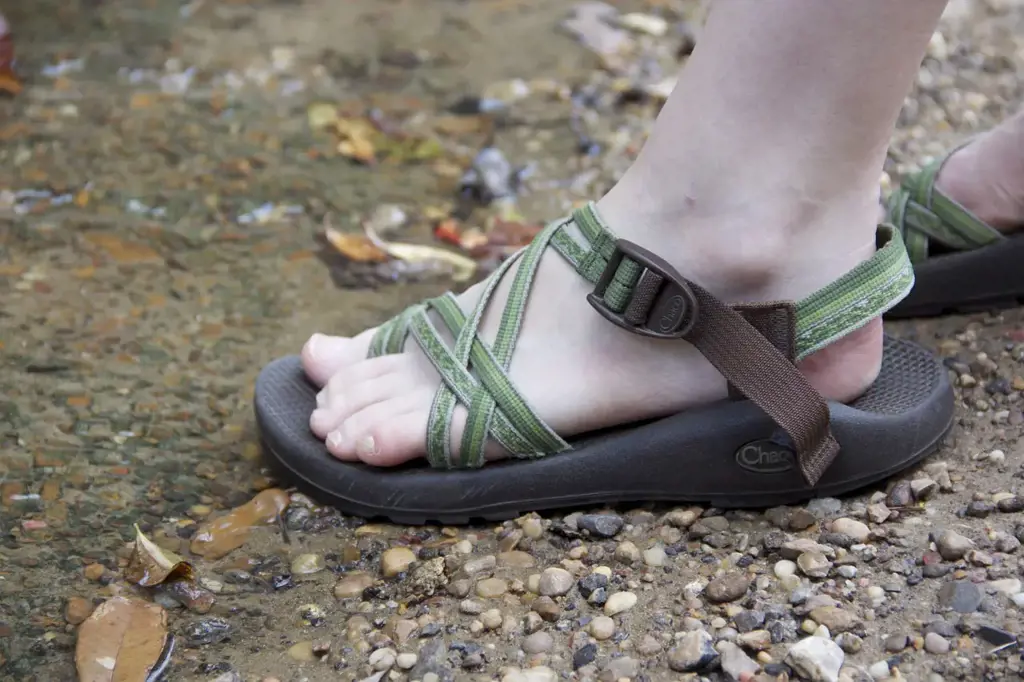
When embarking on a safari in Kenya, it is essential to choose the right type of footwear to ensure comfort and safety throughout your journey. Kenya is known for its diverse landscapes, including rugged terrain, sandy plains, and muddy paths, so having the appropriate footwear can make a significant difference in your overall experience.
Scientifically speaking, a sturdy and supportive pair of hiking boots is recommended for a safari adventure in Kenya. These boots are designed to provide ankle support, protect your feet from sharp rocks or thorny bushes, and offer stability on uneven surfaces. Look for boots with a good tread pattern to ensure traction on different terrains, including wet or slippery surfaces.
From an experiential standpoint, safari guides and seasoned travelers recommend wearing closed-toe shoes to protect your feet from potential injuries. It is not uncommon to encounter sharp rocks or prickly vegetation during game drives or bush walks. Closed-toe shoes also protect your feet from insect bites, which can be a common occurrence in certain areas. It is worth noting that mosquitoes and other insects are most active during dawn and dusk, so having appropriate footwear during these times is particularly important.
Taking a step-by-step approach, let's explore what to consider when choosing footwear for your safari in Kenya:
- Research the specific areas you will be visiting: Different regions in Kenya may have varying terrains, climate conditions, and potential hazards. Some areas may require more specialized footwear than others, so it is important to gather information about the specific locations on your itinerary.
- Assess the time of year: The time of year you visit Kenya can impact the weather conditions and the state of the terrain. For example, during the rainy season (typically April to June and November), you may encounter muddy paths, and waterproof or water-resistant footwear would be beneficial. In contrast, the dry season (usually July to October and January to March) may involve dusty plains where breathable shoes are preferable.
- Consider comfort and fit: Safari adventures often involve long hours of walking or standing, so it is crucial to prioritize comfort. Ensure that your chosen footwear provides a good fit, allowing room for your toes to move without being too loose. It is recommended to try on different brands and styles to find the right fit for your feet.
- Test the shoes before your safari: Once you have selected a pair of shoes, take the time to break them in before your trip. This will help prevent blisters and discomfort during your safari. Wear them on shorter walks or hikes to allow your feet to adjust to the new footwear.
Here are a few examples of appropriate footwear options for a safari in Kenya:
- Hiking boots: As mentioned earlier, hiking boots are an excellent choice for their support, durability, and traction. Opt for a pair made of sturdy materials such as leather or synthetic fabric, with a waterproof or water-resistant feature if you're visiting during the rainy season.
- Trail running shoes: If you prefer a lighter and more flexible option, trail running shoes can be suitable for safaris in less rugged terrains. These shoes offer similar traction and support while providing more breathability and agility.
- Closed-toe sandals or sturdy sneakers: While not as protective as hiking boots, closed-toe sandals or sneakers with a good grip can be appropriate for safaris that involve less walking or are in areas with milder terrain. However, it is important to ensure they offer enough support and protection for your feet.
In conclusion, when planning a safari adventure in Kenya, investing in the right footwear is essential. Consider the scientific recommendations, draw on the experience of safari guides and fellow travelers, follow the step-by-step process of choosing appropriate footwear, and explore examples of suitable options. By doing so, you can ensure a comfortable and safe experience while exploring the beautiful landscapes and wildlife of Kenya.
The Ultimate Backpacking Trip Around the World: What to Pack List
You may want to see also

Are there any specific items I should bring to protect against insects or mosquitoes during a safari in Kenya?
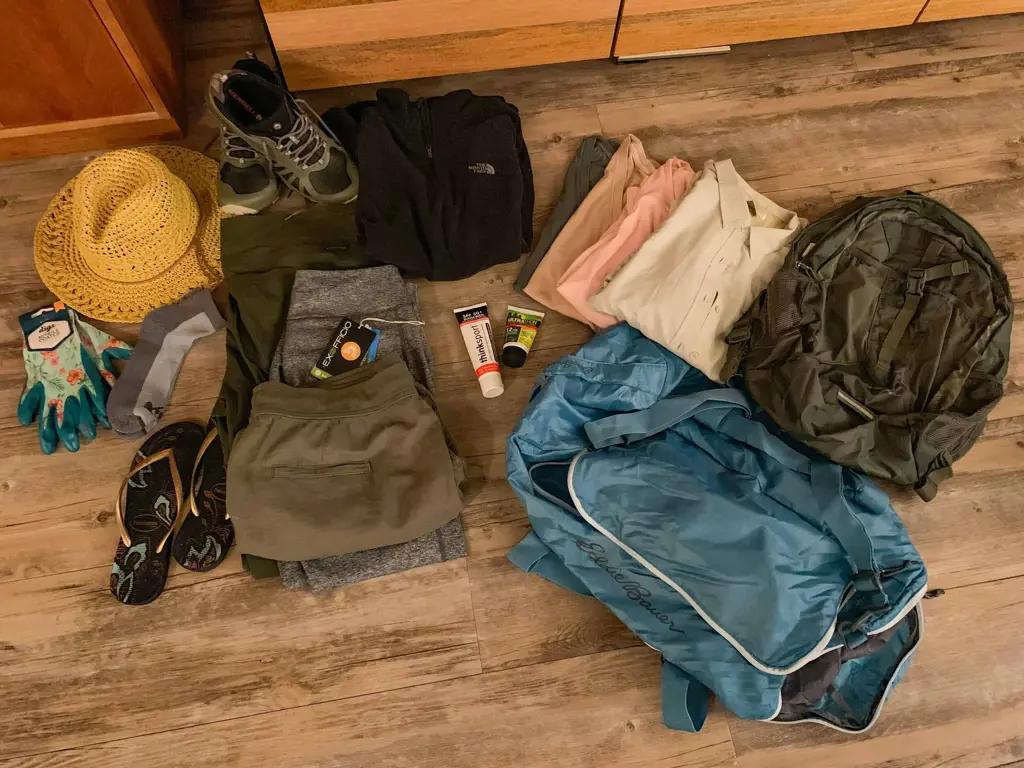
If you are planning a safari in Kenya, it's important to come prepared with the right gear to protect yourself against insects and mosquitoes. Kenya, like many other African countries, is home to a wide variety of insects, including mosquitos, which can carry diseases such as malaria. Here are some specific items you should bring to ensure your safety and comfort during your safari:
- Insect repellent: This is perhaps the most important item to bring when it comes to protecting yourself against mosquitoes and other insects. Look for an insect repellent that contains DEET, as it has been proven to be the most effective at repelling mosquitoes. Make sure to apply the repellent to all exposed areas of skin, and reapply as necessary throughout the day.
- Mosquito net: Many safari accommodations provide mosquito nets for their guests, but it's always a good idea to bring your own just in case. Mosquito nets are a great way to protect yourself while you sleep, as they create a physical barrier between you and the insects. Look for a net that is treated with insecticide for added protection.
- Lightweight, long-sleeved clothing: Wearing lightweight, long-sleeved clothing can provide an extra layer of protection against insect bites. Mosquitoes are attracted to dark colors, so it's best to stick to light-colored clothing. Opt for loose-fitting garments made of breathable fabrics, such as cotton, to help keep you cool in the heat.
- Hats and scarves: In addition to protecting your body with clothing, it's important to protect your head and neck as well. Wearing a hat can shade your face from the sun and also help keep mosquitoes away from your head. A lightweight scarf can be useful for wrapping around your neck to provide additional protection.
- Antihistamines and anti-itch creams: Despite your best efforts, it's still possible to get bitten by insects while on safari. Be prepared by packing antihistamine tablets or creams to help relieve any itching or discomfort caused by insect bites. These can also be useful in case you have an allergic reaction to a bite.
- Closed-toe shoes: While it may be tempting to wear sandals or flip-flops on safari, it's best to opt for closed-toe shoes to protect your feet from insect bites. This is especially important if you plan on going on any walking safaris or hikes. Look for shoes made of breathable materials, such as mesh, to help keep your feet cool.
- Citronella candles or mosquito coils: If you're planning on spending time outdoors in the evenings, it can be helpful to bring citronella candles or mosquito coils. These can help repel mosquitoes and create a more pleasant outdoor environment. Just be sure to follow the manufacturer's instructions for safe use.
By bringing these specific items with you on your safari in Kenya, you can ensure that you are well-prepared to protect yourself against insects and mosquitoes. Remember to always follow the recommended safety guidelines and consult with a healthcare professional before traveling to a malaria-prone area. Enjoy your safari and stay safe!
Essential Packing Tips for Teaching English in Spain
You may want to see also

Is there any specialized equipment or gear that is recommended for a Kenya safari?
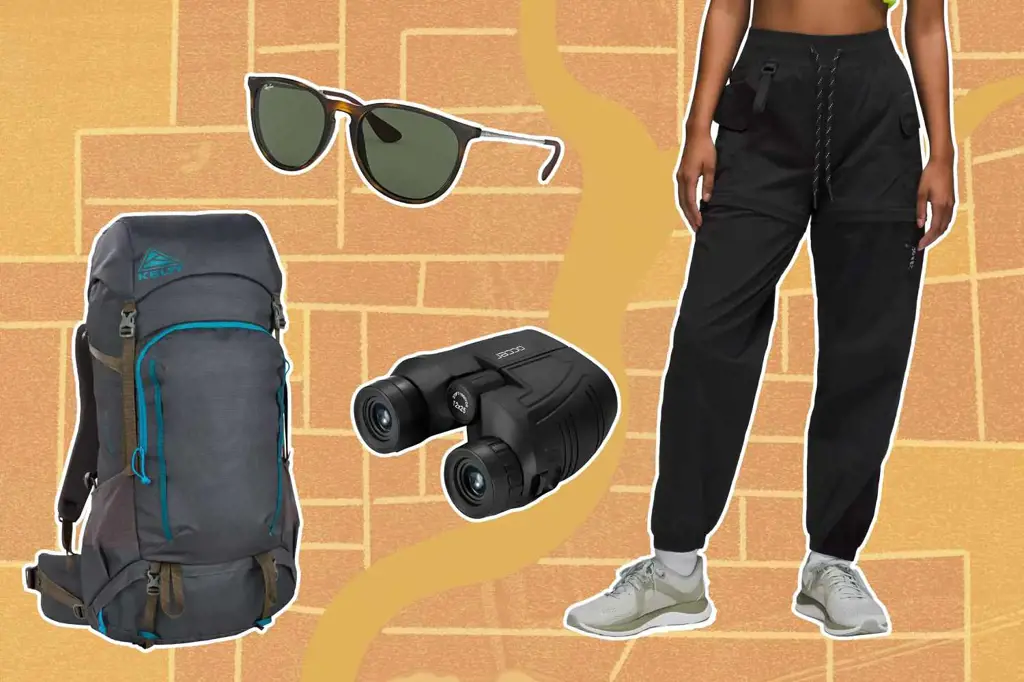
When planning a Kenya safari, it's important to be prepared with the right equipment and gear. Kenya's diverse landscapes and wildlife offer a unique experience, and having the right gear can enhance your safari adventure. Here are some specialized equipment and gear that are recommended for a Kenya safari:
Camera and Binoculars:
A good quality camera with a zoom lens is essential for capturing the stunning wildlife and landscapes in Kenya. Look for a camera with a telephoto lens to get close-up shots of animals from a safe distance. Binoculars are also a must-have to spot animals from afar and observe their behavior in detail.
Safari Clothing:
When it comes to clothing, it's important to prioritize comfort and functionality. Opt for lightweight, breathable, and quick-drying fabrics that help regulate body temperature. Neutral-colored clothing such as khaki or earth tones are recommended to blend in with the natural environment and avoid startling the wildlife. Long-sleeved shirts and pants can provide protection against sunburn, mosquito bites, and thorny bushes.
Hat and Sunglasses:
A wide-brimmed hat is crucial to protect your face and neck from the harsh African sun. Choose a hat with a chin strap to prevent it from flying off during game drives or walks. Sunglasses with UV protection are also essential to shield your eyes from the sun's glare.
Sturdy Shoes:
Comfortable and sturdy footwear is a must for walking safaris or bushwalks. Opt for closed-toe shoes or boots to protect your feet from sharp rocks, thorns, and insects. Make sure your shoes are broken-in and provide good ankle support.
Insect Repellent and Sunscreen:
Kenya is home to various bugs and mosquitoes, so insect repellent is a must-have to keep them at bay. Look for a repellent that contains DEET or other effective ingredients. Additionally, a high SPF sunscreen will protect your skin from the intense African sun.
Headlamp or Flashlight:
A headlamp or flashlight is essential for navigating in the dark, especially during early-morning or nighttime game drives. It will also come in handy for finding your way to the bathroom facilities at the safari camp.
First Aid Kit:
A small first aid kit is always a wise addition to your safari gear. Include items like band-aids, antiseptic ointment, pain relievers, and any necessary personal medications. It's also a good idea to bring along a basic snakebite kit, just in case.
Power Adapter:
Kenya operates on 220-240 volts, so make sure to bring a power adapter if you plan on charging any electronic devices or cameras during your trip. Look for a universal adapter that can accommodate different plug types.
Remember to pack your gear in a sturdy and waterproof bag or backpack to keep everything organized and protected during your safari adventure. It's also worth checking with your safari tour operator or accommodation for any specific recommendations or restrictions regarding gear.
In conclusion, having the right equipment and gear is crucial for a successful and enjoyable Kenya safari. A camera with a zoom lens, binoculars, comfortable safari clothing, a hat, sunglasses, sturdy shoes, insect repellent, sunscreen, a headlamp or flashlight, a first aid kit, and a power adapter are some recommended items to consider. With the right gear, you'll be well-prepared to capture unforgettable moments and fully immerse yourself in the beauty of Kenya's wildlife and landscapes.
Essential Items to Pack for an Unforgettable Oregon Coast Trip
You may want to see also

Are there any cultural considerations to keep in mind when packing for a safari in Kenya?
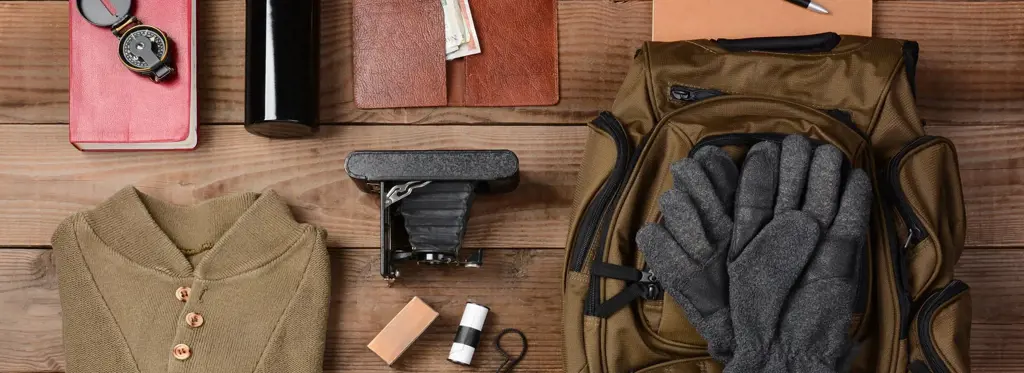
When packing for a safari in Kenya, there are certain cultural considerations that you should keep in mind to ensure you have a respectful and immersive experience. Kenya has a diverse cultural heritage, with over 40 different ethnic groups, each with their own customs and traditions. Here are a few tips to help you navigate the cultural landscape and pack accordingly.
Dress modestly:
In many Kenyan cultures, modesty is highly valued. When packing your safari clothes, choose clothing that covers your shoulders and knees. Opt for lightweight and breathable fabrics to keep you cool in the African heat. It's also a good idea to pack a wide-brimmed hat and sunglasses to protect yourself from the sun.
Respect local customs and traditions:
Kenya is home to vibrant and unique cultural practices. It's important to respect these customs and traditions. For example, if you visit a Maasai village, it is customary to remove your shoes before entering. Educate yourself about the local customs of the specific regions you plan to visit and pack accordingly to show respect for the local culture.
Pack appropriate footwear:
When going on a safari in Kenya, you'll likely be doing a lot of walking and exploring. It's essential to pack comfortable and sturdy footwear. Closed-toe shoes or hiking boots are preferable to protect your feet from potential hazards such as thorns or insects. However, it's also a good idea to pack a pair of sandals or flip-flops for relaxation at your accommodation.
Be mindful of your camera gear:
Kenya's landscapes are breathtaking, and it's natural to want to capture these moments with your camera. However, it's important to be mindful of the local culture when taking photographs. Always ask for permission before photographing people, particularly in villages or sacred sites. Some communities may have cultural beliefs related to photography, and it's important to respect their wishes.
Respect wildlife and the environment:
While on safari, it's crucial to respect the wildlife and the environment. Kenya is known for its diverse flora and fauna, and it's important to engage in responsible tourism practices. Avoid littering, do not disturb the wildlife, and follow the instructions of your guide to ensure the safety and well-being of both the animals and yourself. Ensure you pack any necessary items for responsible travel, such as reusable water bottles and eco-friendly toiletries.
In conclusion, when packing for a safari in Kenya, it's essential to consider the local culture and customs. By dressing modestly, respecting local traditions, packing appropriate footwear, being mindful of your camera gear, and respecting the wildlife and environment, you can ensure a respectful and immersive experience in this beautiful country. Remember to do thorough research about the specific regions you plan to visit to gain a deeper understanding of the local customs and traditions.
Essential Items for Your Skiing Trip: What to Pack for an Unforgettable Adventure
You may want to see also
Frequently asked questions
When packing for a Kenya safari, it's important to choose clothing that is comfortable and suitable for the weather. Be sure to pack lightweight and breathable clothing such as t-shirts, shorts, and pants. It's also important to pack a light jacket or sweater for cooler evenings and early mornings. Don't forget to pack a wide-brimmed hat, sunglasses, and sunscreen to protect yourself from the sun.
When it comes to footwear for a Kenya safari, it's best to pack comfortable and sturdy shoes that can handle a variety of terrains. A pair of closed-toe walking or hiking shoes are ideal, as they provide good support and protection. It's also a good idea to pack a pair of sandals or flip flops for relaxing at the campsite or lodge.
In addition to clothing and footwear, there are several essential items you should pack for a Kenya safari. These include a good quality camera with extra batteries and memory cards to capture all the incredible wildlife and scenery, a pair of binoculars to enhance your wildlife-viewing experience, a lightweight backpack or daypack to carry your essentials during game drives or walks, and a reusable water bottle to stay hydrated.
In addition to the essentials, it's a good idea to pack a few specific items for a Kenya safari. These include insect repellent to protect against mosquitoes and other bugs, a headlamp or flashlight for any nighttime activities, a first aid kit with basic supplies such as band-aids and antiseptic, and a good book or puzzle for downtime in camp. It's also important to check if any specific vaccinations or medications are recommended for the area you will be visiting and pack them accordingly.







